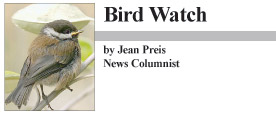Three crows
After breakfast this morning, I was putting a load of laundry into the washing machine when my husband called to me to  drop everything and look out the window. I rushed over to the window in time to see a crow standing on the lawn, and I couldn’t figure out what was exciting about that. Apparently, though, I had just missed a confrontation between the crow and a hawk.
drop everything and look out the window. I rushed over to the window in time to see a crow standing on the lawn, and I couldn’t figure out what was exciting about that. Apparently, though, I had just missed a confrontation between the crow and a hawk.
According to my husband, the hawk, which was about the same size as the crow, landed on the lawn about four or five feet away from the crow and began to move toward it. The crow was not intimidated. He faced the intruder, spread his wings, and hopped up a few inches, perhaps hoping to look big and scary. The threat worked, because the hawk flew away just before two more crows arrived. I took a second look out the window and saw the crow on the ground, another crow perched high on a very big rock and a third one perched on a tree limb. The hawk was nowhere to be seen.
We have noticed three crows hanging around the neighborhood together for much of the summer and fall, and although there is no way to be sure they are the same individuals, I have wondered if they might be siblings. Candace Savage, author of Bird Brains, The Intelligence of Crows, Ravens, Magpies, and Jays, writes that young crows grow up in nuclear families made up of two parents and their offspring. The youngsters are very dependent on their parents, following them around learning to find food, memorizing which routes are safe, and recognizing dangerous predators. Crow families are tightly knit, and extend to large clans. Individuals not only recognize each other, but also are able to discern each other’s moods and intentions. Their complex vocal communications include more than two dozen calls. Crows and their close relatives are flexible and intelligent problem solvers who can learn from experience as well as from watching others. It is also likely their intense social interactions are linked to their high intelligence.
Crows, and other members of the Corvid family, are at the high end of avian intelligence. Their lives are more complicated than the lives of some other birds, so they have to be especially smart to survive. They are generalists, not specialists, able to eat almost anything and to live in various habitats. They have to be able to identify and find a wide variety of food items, and figure out how to adjust to new situations. Until recently, there was limited scientific information on intelligence in animals and birds. It was known that the cerebral cortex in the brains of humans and other mammals is the center of higher thought, and the larger the cerebral cortex in relation to overall body weight the more intelligent the animal. A bird’s cerebral cortex is quite small, but in the 1960s Stanley Cobb, a neurologist, discovered the center of a bird’s higher thought is not the cerebral cortex but a section of the brain called the hyperstriatum, an organ that mammals lack. The larger the hyperstriatum is, the more intelligent the bird would be. It turns out that the brain-to-body-weight of crows, ravens, and magpies nearly matches that of humans.
The brief confrontation between the hawk and the crow on our lawn this morning ended peacefully. The crow was able to size-up the situation correctly, figuring out that the hawk, who hunts from above, did not present as much danger when it was grounded. He was also smart enough to know that a fairly simple threat display probably would intimidate the hawk and make it retreat. By the time reinforcements arrived the problem had been solved neatly. We learned something about crows in those few moments, and maybe the hawk flew away a bit smarter, too, having learned that messing with crows is rarely a good idea.

